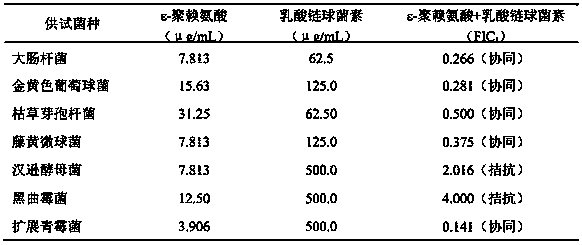Natural bacteriostat composition applied to synergistic inhibition to common microbes
A composition and technology of antibacterial effect, applied in food science, food preservation, application, etc., can solve problems such as large dosage, hidden safety hazards, and narrow antibacterial spectrum
- Summary
- Abstract
- Description
- Claims
- Application Information
AI Technical Summary
Problems solved by technology
Method used
Image
Examples
Embodiment 1
[0011] Example 1: Nisin and ε-polylysine synergistically inhibit Escherichia coli
[0012] Take a 96-well polystyrene microwell plate, after ultraviolet disinfection, use a micropipette to add: 15.626, 7.813, 3.907, 1.953 to the wells of each column along the X-axis direction (from left to right) in the 1st to 8th columns in turn: , 0.977, 0.488, 0.244, 0.122 μg / mL ε-polylysine 25 μL, in the same way, add 125.00, 62.50, 31.25 , 15.625, 7.8125, 3.906, 1.953, 0.977 μg / mL nisin solution 25 μL, mix the two drugs evenly. Add 50 μL of the prepared Escherichia coli bacterial solution in turn, cover the upper plate after adding the solution, shake and mix slightly, place in a constant temperature incubator at 37°C for 24 hours and observe the results, repeat 3 times. Table 2 shows the results of the synergistic inhibition of Escherichia coli by nisin and ε-polylysine. Wells marked with * are synergistic antibacterial wells, and FIC is obtained by substituting into the formula I =0.2...
Embodiment 2
[0017] Example 2: Nisin and ε-polylysine synergistically inhibit Staphylococcus aureus
[0018] Take a 96-well polystyrene microwell plate, after ultraviolet disinfection, use a micropipette to add: 31.26, 15.63, 7.815, 3.908 to the wells of each column along the X-axis direction (from left to right) in the 1st to 8th columns , 1.954, 0.977, 0.488, 0.244 μg / mL ε-polylysine 25 μL, in the same way, add 250.00, 125.00, 62.50 , 31.25, 15.625, 7.813, 3.906, 1.953 μg / mL nisin solution 25 μL, mix the two drugs evenly. Add 50 μL of the prepared Staphylococcus aureus bacterial solution in turn, cover the upper plate after adding the solution, shake and mix slightly, place in a constant temperature incubator at 37°C for 24 hours and observe the results, repeat 3 times. Table 3 shows the results of synergistic inhibition of Staphylococcus aureus by nisin and ε-polylysine, and wells marked with * are synergistic antibacterial wells. Substitute into the formula to get FIC I =0.281. Tha...
Embodiment 3
[0023] Example 3: Nisin and ε-polylysine synergistically inhibit Bacillus subtilis
[0024] Take a 96-well polystyrene microwell plate, after ultraviolet disinfection, use a micropipette to add: 62.50, 31.25, 15.625, 7.812 to the wells of each column along the X-axis direction (from left to right) in the 1st to 8th columns , 3.906, 1.953, 0.977, 0.488 μg / mL ε-polylysine 25 μL, add 125.00, 62.50, 31.25 , 15.625, 7.8125, 3.906, 1.953, 0.977 μg / mL nisin solution 25 μL, mix the two drugs evenly. Add 50 μL of the prepared Bacillus subtilis bacterial solution in turn, cover the upper plate after adding the solution, shake and mix slightly, place in a constant temperature incubator at 37°C for 24 hours and observe the results, repeat 3 times. Table 4 shows the results of the synergistic inhibition of Bacillus subtilis by nisin and ε-polylysine. Wells marked with * are synergistic antibacterial wells, and FIC is obtained by substituting into the formula I =0.500. That is, the mass ...
PUM
 Login to View More
Login to View More Abstract
Description
Claims
Application Information
 Login to View More
Login to View More - R&D
- Intellectual Property
- Life Sciences
- Materials
- Tech Scout
- Unparalleled Data Quality
- Higher Quality Content
- 60% Fewer Hallucinations
Browse by: Latest US Patents, China's latest patents, Technical Efficacy Thesaurus, Application Domain, Technology Topic, Popular Technical Reports.
© 2025 PatSnap. All rights reserved.Legal|Privacy policy|Modern Slavery Act Transparency Statement|Sitemap|About US| Contact US: help@patsnap.com



